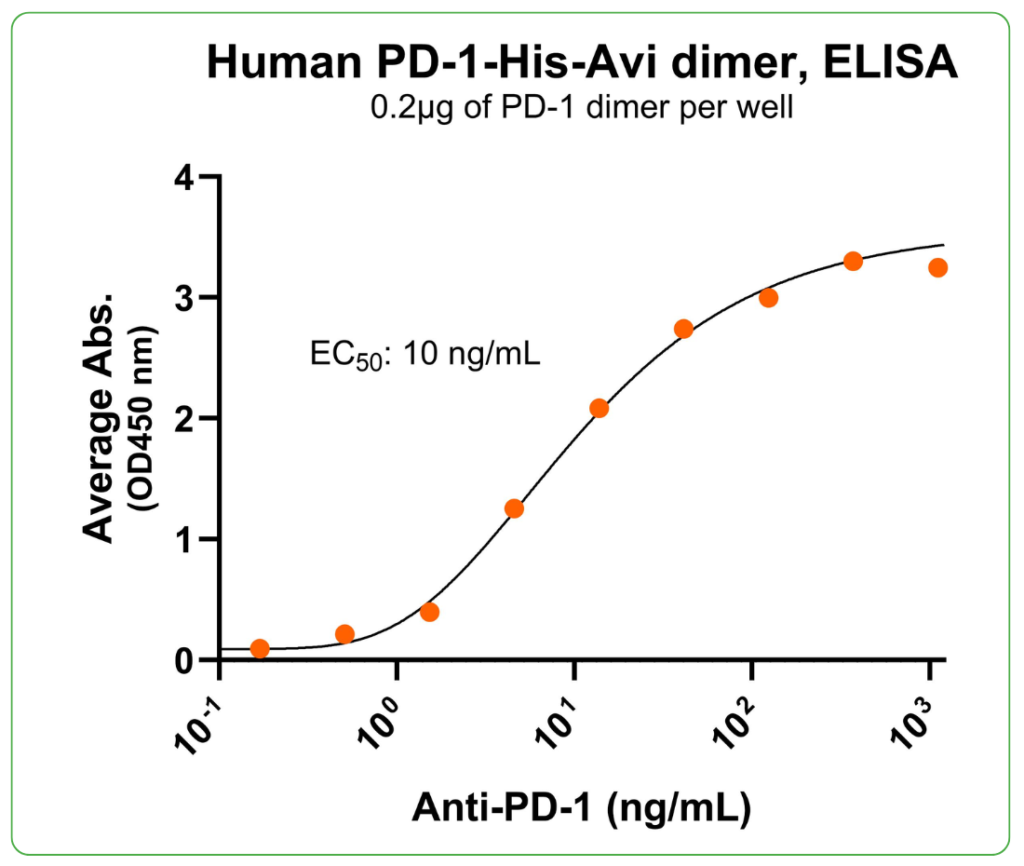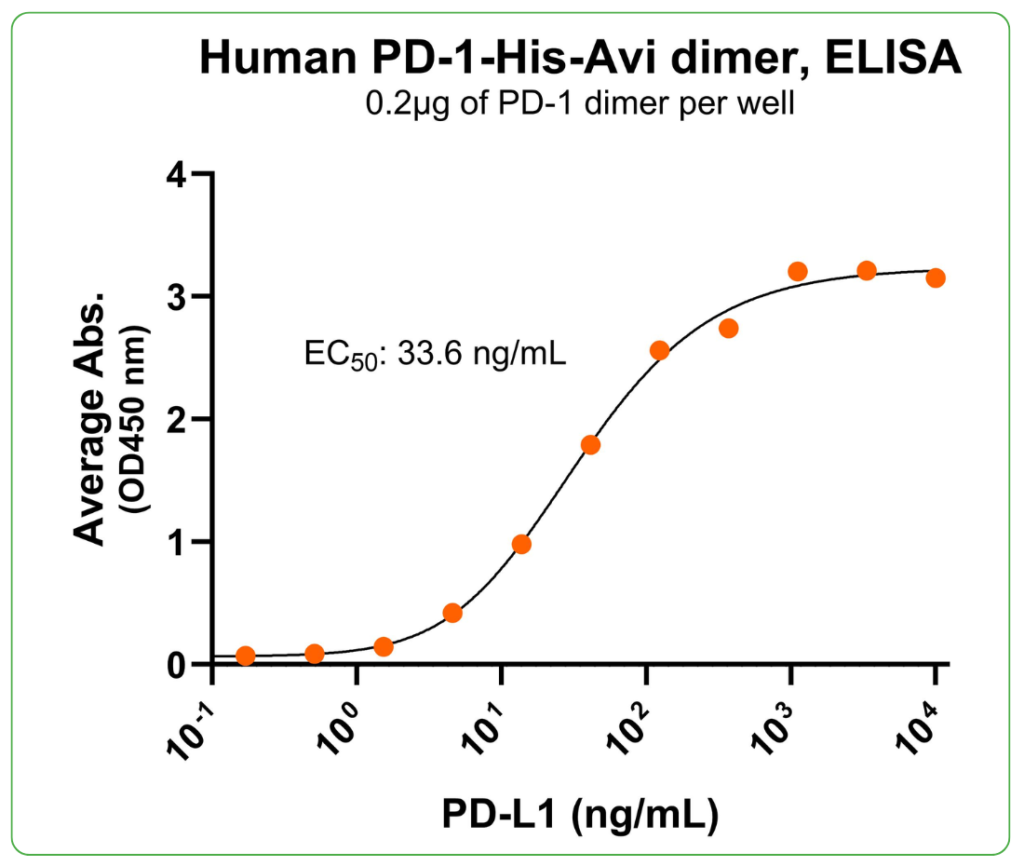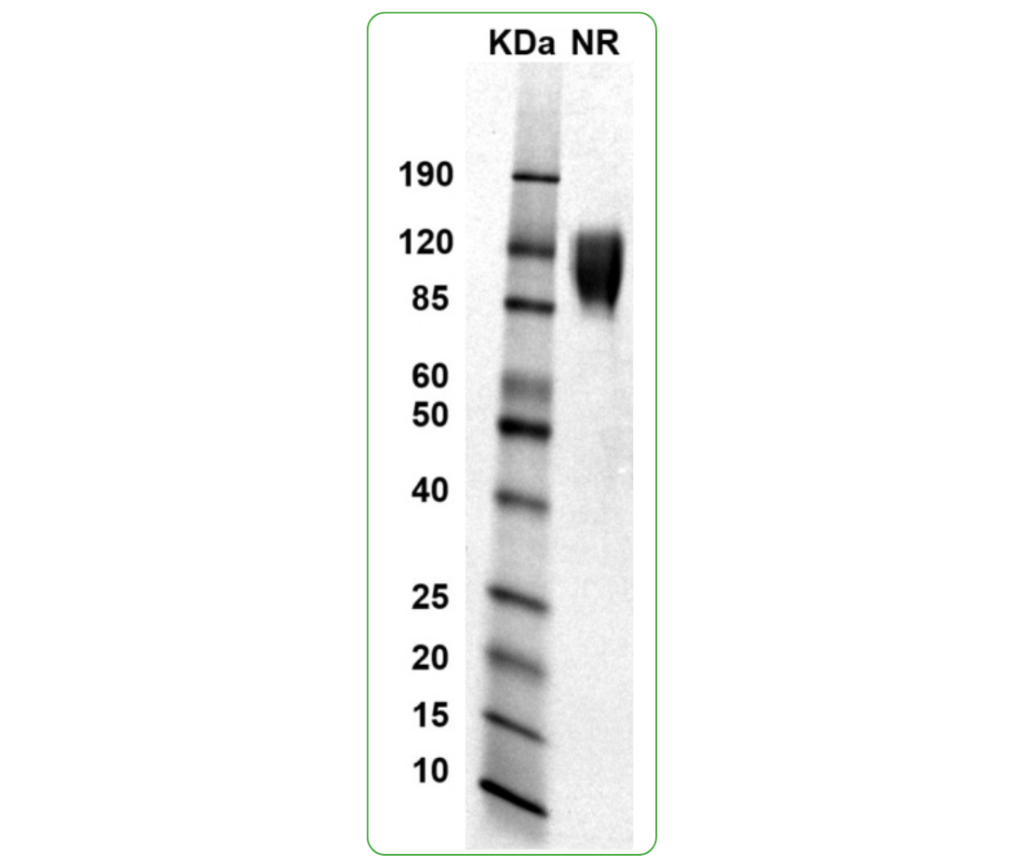Bioactive, Human PD1 Dimer, His-Avi Tag
| Product Code | CSP-24093-03 |
| Expression Host | HEK293T |
| Verified Applications | ELISA for PD-1-specific antibody and PD-L1 ligand protein binding assays. |
| Suggested Applications | ELISA for PD-1-specific antibody and PD-L1 ligand protein binding assays. SPR & BLI for PD-1-specific antibody and PD-L1 protein binding assays. Animal immunization, RUO. |
| Purity | Greater than 90% dimer form as determined by SDS-PAGE under non-reducing condition |
| Amino Acid Range | L25-V170 |
For Research Use Only (RUO)
Price: $125.00
Price: $195.00
Price: $350.00
Price: $750.00
Price: $2,500.00
Bioactivity – Antibody Binding
Immobilized human PD-1-His-Avi dimer protein (CSP-24093-03) at 2 μg/mL (100 μL/well) can bind anti-human PD-1 monoclonal antibody with half maximal effective concentration (EC50) range of 5-20 ng/mL (QC tested).
Bioactivity – Ligand Binding
Immobilized human PD-1-His-Avi dimer protein (CSP-24093-03) at 2 μg/mL (100 μL/well) can bind human PD-L1 with half maximal effective concentration (EC50) range of 16.8-67.1 ng/mL (QC tested).
Specifications
Formulation: 0.22μm filtered PBS, pH 7.4
Shipping: Frozen Dry Ice
Storage: -80°C
Human programmed cell death protein 1 (PD-1), is a Type I membrane protein and cell surface receptor that can form dimers on T cells and B cells and belongs to the immunoglobulin superfamily. The recombinant PD-1 dimer protein (CSP-24093-03) is a cis-homodimer (cis-dimer) and contains a PD-1 extracellular domain (UniProt# Q15116, amino acids Leu25-Val170) fused with a proprietary dimer motif followed by a tandem His-Avi tag at the C-terminus. This dimeric protein is expressed in HEK293T cells. The recombinant human PD-1 dimer protein is bioactive and can bind to PD-L1. It also binds PD-1-specific antibodies. This PD-1 dimer can be used as an antigen for in vitro assays and antibody screening, and as an immunogen for immunization to generate antibodies targeting more conformational epitopes.
Protein Name: PD1
UniProt #: Q15116
Predicted Molecular Weight: 52 kDa
SDS PAGE Molecular Weight: The migration range of the dimer protein with glycosylation under non-reducing conditions is 85-125 kDa on SDS PAGE.
Protein Construct: PD-1 dimer protein contains a PD-1 extracellular domain (UniProt# Q15116) fused with a proprietary dimer motif followed by a tandem His-Avi tag at the C-terminus.
Background
Human programmed cell death protein 1 (PD-1), is a Type I membrane protein and cell surface receptor on T cells and B cells and belongs to the immunoglobulin superfamily. PD-1 is also known as PDCD1, cluster of differentiation 279 (CD279), systemic lupus erythematosus susceptibility 2 (SLEB2), and systemic lupus erythematosus susceptibility (hSLE1). PD-1 contains an extracellular immunoglobulin-V-like (Ig-V-like) domain followed by a transmembrane region, and an intracellular tail. PD-1 is an immune checkpoint that binds two ligands, PD-L1 and PD-L2, which are members of the B7 family. PD-L1 serves as an immunosuppressive ligand for PD-1 and the overexpression of PD-L1 on many tumor cells can prevent the immune system from attacking tumors. Inhibition of the interaction between PD-1 and PD-L1 can enhance antitumor activity, which has led to a new class of drugs called PD-1 inhibitors to activate the immune system and treat certain types of cancer. Although previously considered monomeric, PD-1 has been shown to have a propensity for forming homodimers and this homodimerization increases the potency of its activity. Therefore, a recombinant protein mimicking the PD-1 dimer conformation can be crucial for cancer therapeutic discovery.
Alternate Names: PDCD1, cluster of differentiation 279, CD279, PD1, systemic lupus erythematosus susceptibility 2, SLEB2, hPD-1, hPD-l, systemic lupus erythematosus susceptibility, hSLE1



